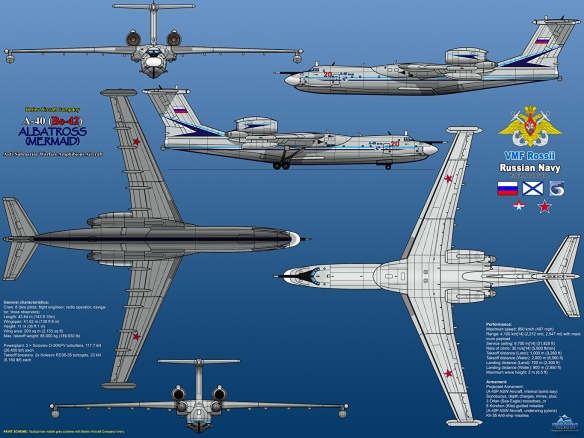Beriev A-40
For a period from the mid-1960s the Beriev design bureau’s work on military flying boats fell away because official interest moved towards alternative types. However, in 1976 some preliminary studies were initiated for a new generation anti-submarine flying boat. The project was eventually proposed to the Government by Chief Designer A K Konstantinov and in 1983, following his prompting, the Soviet Union’s Defence Industry Committee issued an order to go ahead with the design, called Be-42 or A-40, to replace the Be-12 and the Ilyushin Il-38 land-based maritime aircraft. The A-40 maritime patrol and surveillance aircraft was designed to deal with submarines and surface ships at close and medium distances from home bases and also provide access to remote areas in the eastern sectors of the Soviet Union; it was to be powered by two Soloviev D-30KPV main engines and two Klimov RD-60Ks.
Two prototypes were built and the first made its maiden flight from a land runway in December 1986, following this with its first water take-off in November 1987. Publicly revealed at the Tushino airshow in August 1989, the type was eventually named Albatros (and designated Mermaid by NATO) and was proposed in numerous military and civil versions. By 2002 a prototype of the military A-42 variant was planned with more advanced avionics and powered by D-27A propfan engines that offered improved fuel efficiency.
Beriev Be-10
As a result of the bureau’s newly won experience with jet-powered flying boats, the next step was to create an aircraft that would be suitable for service use and the result was the second aircraft to receive the Be-10 designation (the initial designation was ‘Article M’). This began as a proposed reconnaissance/ strike torpedo-carrying flying boat capable of dealing with enemy warships and transports and came into existence after the OKB had received an official request for such a type from E N Preobrazhensky, the Commander of the AVMF (naval aviation) – Admiral of the Fleet N G Kuznetsov also offered his support. This move was followed by an official resolution dated 8th October 1953, the receipt of which was a big step forwards for the Beriev design bureau.
Unlike previous flying boats, the offensive weaponry was housed in an internal bomb bay with doors in the bottom hull behind the planing step. The R-l’s straight wing was replaced by an alternative with moderate sweepback and the Be-10’s full design had been completed by 15th May 1954. It showed an aircraft that was much bigger than the R-l and the mock-up was officially examined between 7th June and 15th July; the first prototype had been completed by October 1955. However, the OKB’s home base presented a problem in that every winter Taganrog Bay froze over, which automatically stopped the flight testing of flying boats and seaplanes for a good proportion of the year. An alternative was required that would remain open all year round and the final choice was Gelendzhik.
As a result the Be-10 was towed to Gelendzhik in a floating dock and made its maiden flight from there on 20th June 1956; in due course it successfully completed its state acceptance testing, although not without some teething troubles. However, the 27 production aeroplanes that followed, manufactured between 1958 and 1961, were all assembled at Taganrog. The type entered service in mid-1959 and for many years was the world’s only all-jet flying boat to become fully operational; in the West the Be-10 was codenamed Mallow. (A few production examples of the American Martin XP6M-1 Seamaster flying boat, powered by four jet engines, were taken on charge but were not a success). In August 1963 the Be-10 was grounded for two reasons – three boats had recently crashed, with some fatalities, while, in addition, cracks had been found in the Al-8 alloy structural parts of several other airframes; after sitting idle for five years, all of the survivors were eventually scrapped.
Beriev Be-10N
The Be-10’s offensive stores comprised three RAT-52 rocket-assisted torpedoes, up to twelve 5511b (250kg) or one 6,6141b (3,000kg) bomb, or three mines but, overall, this was considered to be a relatively limited warload. Consequently a follow-on Be-10N version was designed to carry two K-12BS anti-ship cruise missiles on underwing pylons, thus giving the type the ability to attack larger warships, other surface vessels and coastal targets. The K-l 2BS could receive conventional or nuclear-tipped warheads and on 31st July 1958 an official Ministry resolution was passed to cover the design. The structural changes made to the basic Be-10 came in the form of a much larger nose cone (for the massive K-12U Shpil targeting radar scanner) and in the weapon bay, but the avionics were also upgraded and improved. Maximum take-off weight was 106,9221b (48,500kg) and combat radius about 901 miles (1,450km), while the missile would be launched at 32,808ft (10,000m) about 62 miles (100km) from its target. The draft design was submitted to officials and gained SovMin approval on 10th June 1959, but no instructions to proceed were ever issued. A later Be-10S preliminary proposal, which was intended to carry the SK-1 Skalp nuclear depth charge, was abandoned in August 1960.
